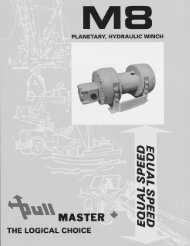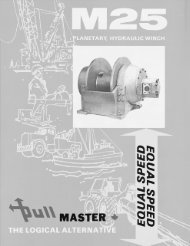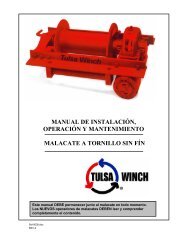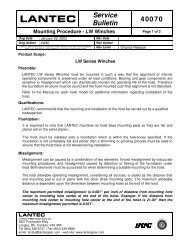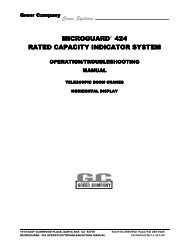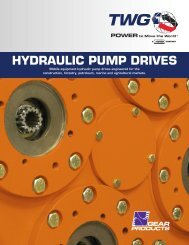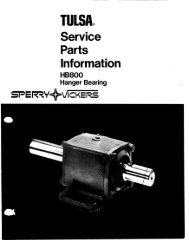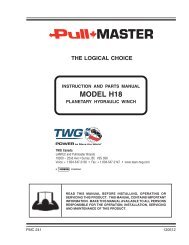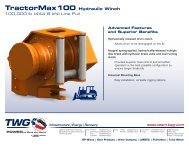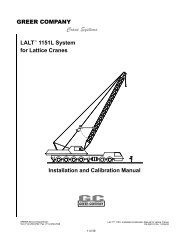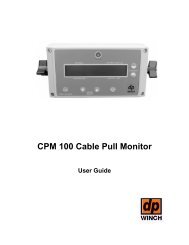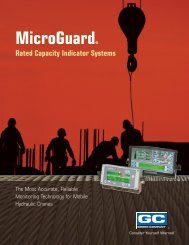Model PL2 Service Manual - TWG
Model PL2 Service Manual - TWG
Model PL2 Service Manual - TWG
You also want an ePaper? Increase the reach of your titles
YUMPU automatically turns print PDFs into web optimized ePapers that Google loves.
TROUBLE SHOOTING<br />
GENERAL:<br />
In most cases, when the hydraulic winch does not perform satisfactorily, the cause for malfunction is<br />
found somewhere in the hydraulic circuit. Before the winch is removed from its mounting and<br />
disassembled, all of the hydraulic circuit components should be checked for proper function.<br />
IMPORTANT:<br />
The hydraulic oil volume relates to the line speed or rpm of the winch.<br />
Therefore, if the winch does not produce the specified maximum rated line speed or drum rpm, a loss<br />
of hydraulic flow somewhere in the hydraulic circuit can be analysed. If this condition exists, install<br />
a flow meter into the hydraulic circuit to check the volume of oil supplied to the pressure port of the<br />
hydraulic winch motor when the winch control is completely opened. The flow meter should indicate<br />
the maximum operating volume. If this test indicates a loss of hydraulic flow, check the hydraulic pump,<br />
the relief valve and the control valve. If the pump is driven by V-belts, check for belt slippage.<br />
The hydraulic pressure relates to the pulling capacity of the winch.<br />
If the winch will not produce the specified maximum line pull, install a pressure gauge in the pressure<br />
line leading to the hoisting port on the hydraulic winch motor. Stall the winch to prevent rotation of<br />
the drum and then open the control valve. Check the hydraulic pressure reading of the installed<br />
pressure gauge. If the pressure reads below the specified maximum operating pressure, look for<br />
trouble in the hydraulic pump, the relief valve and the control valve. If the hydraulic pump is driven<br />
by V-belts, check for belt slippage. When checking oil pressure and volume in the hydraulic circuit,<br />
verify that the hydraulic reservoir is filled to the top level and the hydraulic pump is running at maximum<br />
operating rpm.<br />
Only after the hydraulic system has been checked and found to be in order, use the following indications<br />
for probable causes of failure in the winch:<br />
Winch will not produce line speed at maximum<br />
volume as listed in SPECIFICATIONS.<br />
Winch will not reverse.<br />
FAILURE<br />
Winch will not produce line pull at maximum<br />
pressure as listed in SPECIFICATIONS.<br />
PROBABLE CAUSE<br />
a) Winch is mounted to an uneven surface.<br />
(See INSTALLATION INSTRUCTIONS.)<br />
b) Cable sheaves or block purchase operated with the<br />
winch are not turning freely.<br />
c) Damage or wear in the hydraulic motor.<br />
d) The relief valve pressure may be set too low.<br />
(See SPECIFICATIONS for maximum operating pressure.)<br />
e) Excessive back pressure in the hydraulic circuit<br />
a) Winch is mounted to an uneven surface.<br />
(See INSTALLATION INSTRUCTIONS.)<br />
b) Cable sheaves or block purchase operated with the<br />
winch are not turning freely.<br />
c) Damage or wear in the hydraulic motor.<br />
d) Excessive back pressure in the hydraulic circuit.<br />
a) Leakage out of the brake piston prevents the disc<br />
brake from being released against the brake springs.<br />
This is caused by damage to the O-rings on the brake<br />
piston or connecting tube.<br />
b) Insufficient hydraulic pressure.<br />
(See SPECIFICATIONS for minimum operating pressure.)<br />
c) Winch is mounted to an uneven surface.<br />
(See INSTALLATION INSTRUCTIONS.)<br />
d) Hydraulic pressure is not reaching the brake piston<br />
due to plugged connecting tube.<br />
PAGE 12<br />
315 REV.990607



